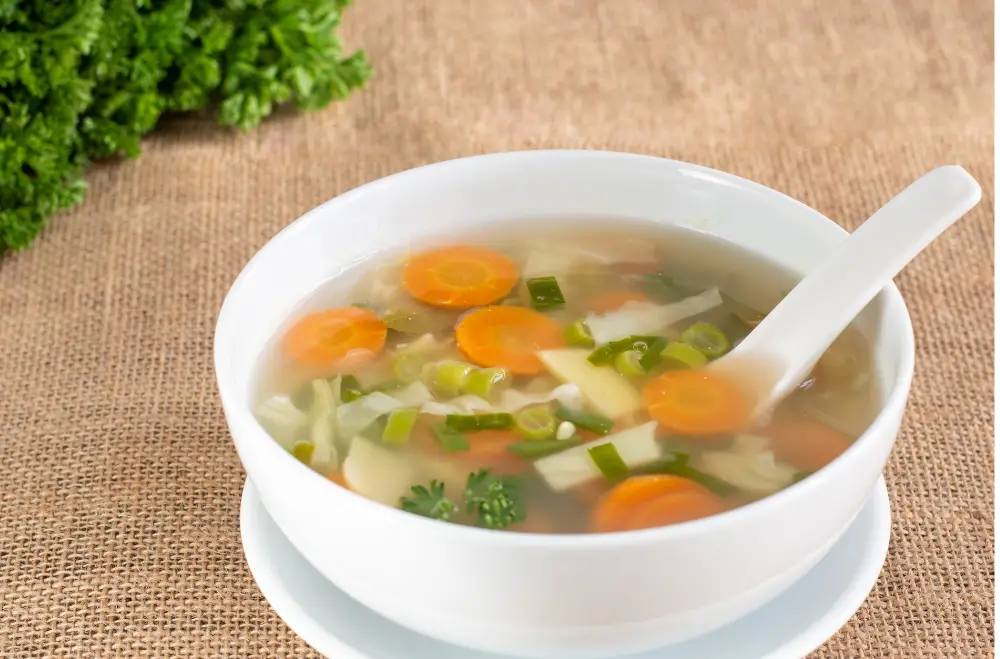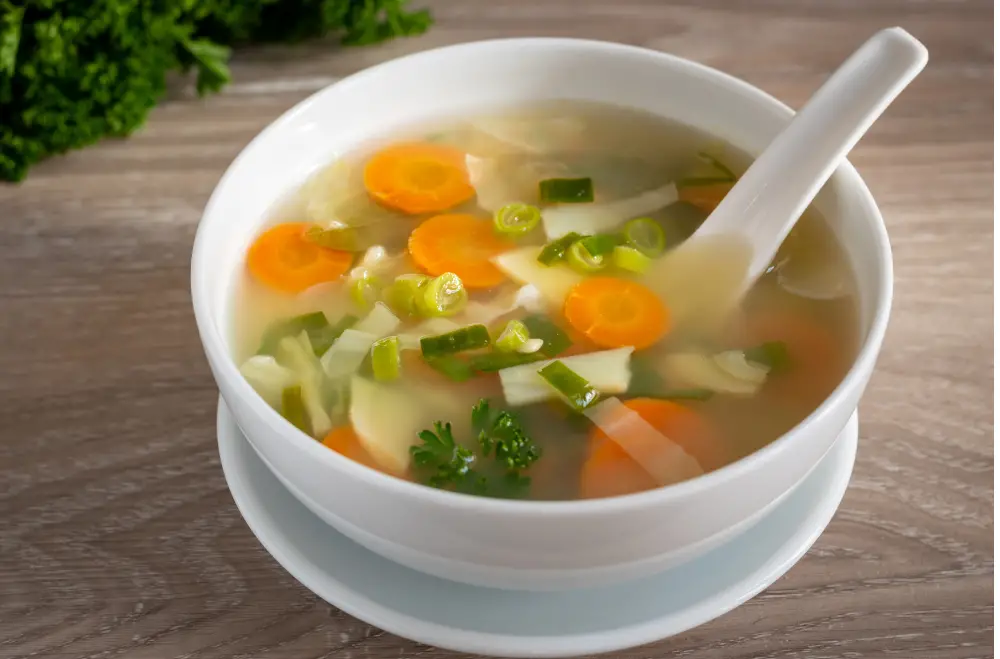Introduction to Vegetable Soup
Vegetable soup, a quintessential comfort food, embodies the essence of home cooking. It’s a dish that transcends cultural boundaries, offering a warm embrace in a bowl. Beyond its comforting appeal, vegetable soup serves as a nutritional powerhouse, loaded with vitamins, minerals, and fibers, essential for a healthy diet. Its versatility allows for endless variations, making it a beloved meal worldwide.
The Rich Tapestry of Vegetable Soup’s History
Tracing the origins of vegetable soup is like walking through a global culinary museum. Every culture has contributed to the evolution of this dish, adapting it to suit local tastes, available produce, and dietary needs. From the hearty Minestrone of Italy to the spicy Tom Yum of Thailand, vegetable soup has taken on many forms, each reflecting the unique character and culinary traditions of its homeland.
A Nutritional Cornerstone
The health benefits of vegetable soup are vast, making it a staple for those seeking a nutritious diet. It’s an excellent way to consume a variety of vegetables in one sitting, ensuring a diverse intake of essential nutrients. Rich in dietary fiber, vegetable soup aids in digestion and can help maintain a healthy weight. The high water content also helps in hydration, making it a nourishing choice for overall health and well-being.
Exploring Popular Varieties
Venture into any corner of the world, and you’ll find a version of vegetable soup. In France, there’s the elegant Soupe au Pistou, a celebration of summer vegetables seasoned with basil pesto. Russia boasts its Beetroot-based Borscht, a vibrant dish that can be served hot or cold. Across the Atlantic, the United States offers a myriad of vegetable soups, from the simple yet satisfying vegetable beef soup to innovative creations that cater to the health-conscious crowd.
Each variety of vegetable soup tells a story, a reminder of the shared human experience of gathering around a meal. It’s a testament to the adaptability and creativity of cooks throughout history, who have continuously reinvented this dish while keeping its comforting essence intact.
Ingredients for a Basic Vegetable Soup
Creating a basic vegetable soup requires a foundation of simple, yet flavorful ingredients. This versatile dish can be adapted based on seasonal availability or personal preference, making it a staple in kitchens worldwide. Here’s a guide to assembling the essential components for a nourishing and delicious basic vegetable soup.
Essential Vegetables
- Carrots: Add sweetness and color, rich in beta-carotene for eye health.
- Celery: Provides a subtle bitterness and crunch, contributing to the soup’s base flavor.
- Onions: A foundational ingredient, onions add depth and a slight sweetness when sautéed.
- Garlic: Offers a pungent kick that becomes mellow and aromatic when cooked.
- Potatoes: Serve as a thickening agent, adding heartiness and texture.
- Tomatoes: Fresh or canned, tomatoes add acidity and richness, brightening the soup.
Liquid Base
- Vegetable Broth: The choice of broth can significantly influence the overall flavor of the soup. A good quality vegetable broth serves as the liquid base, providing depth and richness.
- Water: Can be used in place of or alongside broth, depending on taste preferences and dietary needs.
Optional Add-Ons
- Green Beans: Offer a nice snap and a fresh, green flavor.
- Zucchini: Adds a mild taste and soft texture, integrating well with other ingredients.
- Peas: Frozen or fresh, peas bring sweetness and vibrant color.
- Leafy Greens: Spinach, kale, or Swiss chard wilt into the soup, adding nutrients and color.
- Herbs: Fresh or dried herbs such as parsley, thyme, oregano, or bay leaves enhance the soup with their aromatics.
- Spices: A dash of paprika, black pepper, or a pinch of red pepper flakes can introduce warmth and complexity.
Preparation Essentials
- Olive Oil: For sautéing the base vegetables, olive oil adds a hint of richness and helps to release their flavors.
- Salt and Pepper: Essential for seasoning, they enhance the natural flavors of the vegetables.
Putting It All Together
The beauty of vegetable soup lies in its simplicity and flexibility. Begin by sautéing onions, carrots, and celery in olive oil until soft. Add garlic and cook until fragrant. Pour in the vegetable broth, followed by the remaining vegetables, herbs, and spices. Bring to a boil, then reduce to a simmer, allowing the soup to cook until the vegetables are tender. Season with salt and pepper to taste.
Step-by-Step Cooking Guide

Creating a hearty and flavorful vegetable soup is a simple and rewarding process. This step-by-step cooking guide will walk you through the basics of making a basic vegetable soup from scratch, ensuring a delicious result every time. Whether you’re a novice cook or an experienced chef, this guide makes it easy to bring a comforting bowl of vegetable soup to the table.
Step 1: Gather Your Ingredients
- Essential vegetables: carrots, celery, onions, garlic, potatoes, tomatoes
- Liquid base: vegetable broth (or water)
- Optional add-ons: green beans, zucchini, peas, leafy greens
- Seasonings: olive oil, salt, pepper, herbs (parsley, thyme, oregano, bay leaves), spices (paprika, black pepper, red pepper flakes)
Step 2: Prepare Your Vegetables
- Wash all vegetables thoroughly under running water.
- Peel and dice carrots, potatoes, and any other root vegetables.
- Finely chop celery, onions, and garlic.
- Cut any larger vegetables like zucchini or green beans into bite-sized pieces.
- If using leafy greens, rinse well and roughly chop.
Step 3: Sauté the Base Vegetables
- Heat olive oil in a large pot over medium heat.
- Add the chopped onions, carrots, and celery to the pot.
- Sauté the vegetables for about 5-7 minutes or until they begin to soften and the onions become translucent.
- Add the minced garlic and cook for another minute until fragrant.
Step 4: Add the Broth and Remaining Vegetables
- Pour the vegetable broth (or water) into the pot with the sautéed vegetables.
- Add the diced potatoes, tomatoes, and any other vegetables you’re using to the pot.
- Stir to combine all the ingredients well.
Step 5: Season Your Soup
- Add your chosen herbs and spices to the pot. A bay leaf, some thyme, and oregano are great for starting.
- Season with salt and pepper to taste.
- Stir well to ensure the seasonings are evenly distributed throughout the soup.
Step 6: Bring to a Boil and Simmer
- Increase the heat and bring the soup to a boil.
- Once boiling, reduce the heat to low and cover the pot with a lid.
- Let the soup simmer for about 20-30 minutes, or until all the vegetables are tender.
Step 7: Final Adjustments and Serving
- Taste the soup and adjust the seasoning if necessary, adding more salt, pepper, or herbs as needed.
- If the soup is too thick, add more broth or water until you reach your desired consistency.
- Remove the bay leaf (if used) before serving.
- Serve the soup hot, garnished with fresh herbs or a sprinkle of grated cheese if desired.
Additional Tips
- Customization: Feel free to add or substitute ingredients based on preferences or what you have on hand. Lentils, beans, or small pasta shapes can also be added for extra heartiness.
- Texture: For a thicker soup, blend a portion of the soup and then mix it back in.
- Storage: Vegetable soup stores well in the refrigerator for up to 4 days and can be frozen for up to 3 months.
Following these steps will result in a delicious, comforting bowl of vegetable soup that’s perfect for any season. Enjoy the process of cooking and the delightful flavors of your homemade soup.

